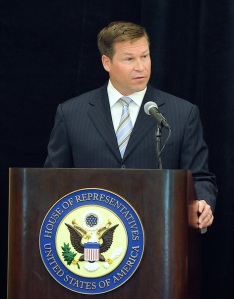The second quarter campaign fundraising totals are being released into the public domain, revealing a number of House challengers actually raising a greater amount of money than their incumbent opponents. Today we take a look at a few of those stand-out candidates.
In California, Independent Bill Bloomfield posted an impressive second quarter total of $1.299 million, most of it from himself, as compared to the $180,000 raised by his opponent, 37-year congressional veteran Henry Waxman (D). Bloomfield spent heavily to top a slate of six other candidates in the June 5 jungle primary for the right to challenge Rep. Waxman in the newly drawn 33rd congressional district. Bloomfield, a former Republican who turned Independent after co-founding the “No Labels” business, has self-contributed more than $1 million to his own campaign, but the move is apparently making him somewhat viable against Waxman.
As we all know, the amount of money one spends on his campaign is not always commensurate with victory. Such is likely to occur in the new 33rd, as the Democratic voting patterns in a presidential election year will, of course, favor the Democratic congressional candidate. Though we are likely to see Bloomfield wage a spirited battle, Waxman is still the decided favorite to win a 20th term in the House later this year even though he currently represents just less than half of the new CA-33.
Looking at the newly re-drawn 7th district of Colorado, incumbent Rep. Ed Perlmutter (D) may also be looking at a more formidable challenge than originally expected from Joseph Coors Jr., the great-grandson of brewer and Coors Beer Company founder, Adolph Coors. Mr. Coors reported taking in $787,000 in Q2 compared to Perlmutter’s $505,000. Reports indicate, however, that Coors made a personal contribution of $397,000 to his campaign during the quarter but, regardless of the source of his funding, the beer fortune heir and former CEO of different Coors Corporation-related businesses has spendable dollars in his campaign treasury.
Turning to Illinois, former US Veterans Affairs Assistant Secretary Tammy Duckworth (D) raised $889,000 in the second quarter as compared to Tea Party-backed incumbent Rep. Joe Walsh’s $318,000. Duckworth out-raised the freshman congressman by a better than 2:1 ratio. This race is sure to garner significant national attention come Election Day, and is one to watch. Arguably, IL-8 is the best Democratic conversion opportunity in the nation, and Duckworth’s candidate and fundraising abilities are putting her in position to take strong advantage of her political situation.
Finally, we take a look at the Sunshine State and a key race in Florida’s 10th Congressional district. Orlando former Police Chief, Val Demings (D) raised $292,000 in Q2 compared to freshman incumbent, Rep. Daniel Webster’s (R) $191,000. Demings has shown strong fundraising prowess with this being her fourth consecutive quarter bringing in more money than her incumbent opponent. The district, previously represented by Democrat Alan Grayson, switched from blue to red with Webster’s win in 2010 and became significantly more Republican in the GOP redistricting plan, by a net of nine points on the Obama-McCain 2008 presidential scale.
Additionally, the following candidates all raised more than their incumbent opponents during the 2nd quarter, meaning that we will likely hear from all of them before this election cycle concludes.
Democratic challengers raising more than their incumbent opponents:
- Ami Bera – CA-7 – against Rep. Dan Lungren (R)
- Eric Swalwell – CA-15 – paired with fellow Democratic Rep. Pete Stark
- John Delaney – MD-6 – opposing Rep. Roscoe Bartlett (R)
- Bill Foster – IL-11 – challenging Rep. Judy Biggert (R)
- Cheri Bustos – IL-17 – opposing Rep. Bobby Schilling (R)
- Dave Crooks – IN-8 – against Rep. Larry Bucshon (R)
- Ann McLane Kuster – NH-2 – challenging Rep. Charlie Bass (R)
- Shelley Adler – NJ-3 – opposing Rep. Jon Runyan (R)
- Uprenda Chivukula – NJ-7 – against Rep. Leonard Lance (R)
Only two Republican challengers forged passed their incumbent opponents in terms of cash raised in the 2nd Quarter:
- Ricky Gill – CA-9 – challenging Rep. Jerry McNerney (D)
- Richard Tisei – MA-6 – opposing Rep. John Tierney (D)




